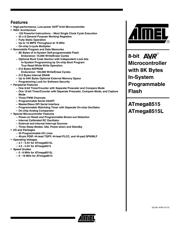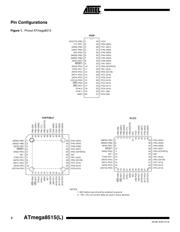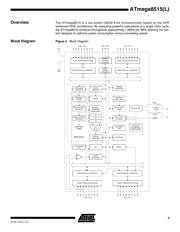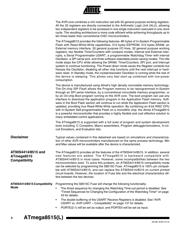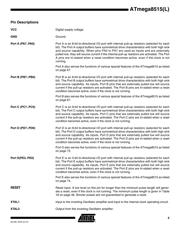Datasheet 搜索 > 8位微控制器 > ATMEL(爱特美尔) > ATMEGA8515-16PU 数据手册 > ATMEGA8515-16PU 数据手册 5/258 页
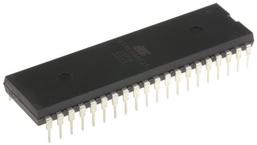
 器件3D模型
器件3D模型¥ 14.424
ATMEGA8515-16PU 数据手册 - ATMEL(爱特美尔)
制造商:
ATMEL(爱特美尔)
分类:
8位微控制器
封装:
DIP-40
描述:
ATMEL ATMEGA8515-16PU 微控制器, 8位, 低功率高性能, ATmega, 16 MHz, 8 KB, 512 Byte, 40 引脚, DIP
Pictures:
3D模型
符号图
焊盘图
引脚图
产品图
页面导航:
引脚图在P2P5P61P97Hot
原理图在P3P8P59P80P81P82P84P98P103P104P106P108
封装尺寸在P245P246P247P248
型号编码规则在P244
封装信息在P245P251
应用领域在P31P45P54P57P166P169P179P180
电气规格在P59P251
导航目录
ATMEGA8515-16PU数据手册
Page:
of 258 Go
若手册格式错乱,请下载阅览PDF原文件

5
ATmega8515(L)
2512K–AVR–01/10
Pin Descriptions
VCC Digital supply voltage.
GND Ground.
Port A (PA7..PA0) Port A is an 8-bit bi-directional I/O port with internal pull-up resistors (selected for each
bit). The Port A output buffers have symmetrical drive characteristics with both high sink
and source capability. When pins PA0 to PA7 are used as inputs and are externally
pulled low, they will source current if the internal pull-up resistors are activated. The Port
A pins are tri-stated when a reset condition becomes active, even if the clock is not
running.
Port A also serves the functions of various special features of the ATmega8515 as listed
on page 67.
Port B (PB7..PB0) Port B is an 8-bit bi-directional I/O port with internal pull-up resistors (selected for each
bit). The Port B output buffers have symmetrical drive characteristics with both high sink
and source capability. As inputs, Port B pins that are externally pulled low will source
current if the pull-up resistors are activated. The Port B pins are tri-stated when a reset
condition becomes active, even if the clock is not running.
Port B also serves the functions of various special features of the ATmega8515 as listed
on page 67.
Port C (PC7..PC0) Port C is an 8-bit bi-directional I/O port with internal pull-up resistors (selected for each
bit). The Port C output buffers have symmetrical drive characteristics with both high sink
and source capability. As inputs, Port C pins that are externally pulled low will source
current if the pull-up resistors are activated. The Port C pins are tri-stated when a reset
condition becomes active, even if the clock is not running.
Port D (PD7..PD0) Port D is an 8-bit bi-directional I/O port with internal pull-up resistors (selected for each
bit). The Port D output buffers have symmetrical drive characteristics with both high sink
and source capability. As inputs, Port D pins that are externally pulled low will source
current if the pull-up resistors are activated. The Port D pins are tri-stated when a reset
condition becomes active, even if the clock is not running.
Port D also serves the functions of various special features of the ATmega8515 as listed
on page 72.
Port E(PE2..PE0) Port E is an 3-bit bi-directional I/O port with internal pull-up resistors (selected for each
bit). The Port E output buffers have symmetrical drive characteristics with both high sink
and source capability. As inputs, Port E pins that are externally pulled low will source
current if the pull-up resistors are activated. The Port E pins are tri-stated when a reset
condition becomes active, even if the clock is not running.
Port E also serves the functions of various special features of the ATmega8515 as listed
on page 74.
RESET
Reset input. A low level on this pin for longer than the minimum pulse length will gener-
ate a reset, even if the clock is not running. The minimum pulse length is given in Table
18 on page 46. Shorter pulses are not guaranteed to generate a reset.
XTAL1 Input to the inverting Oscillator amplifier and input to the internal clock operating circuit.
XTAL2 Output from the inverting Oscillator amplifier.
器件 Datasheet 文档搜索
AiEMA 数据库涵盖高达 72,405,303 个元件的数据手册,每天更新 5,000 多个 PDF 文件
